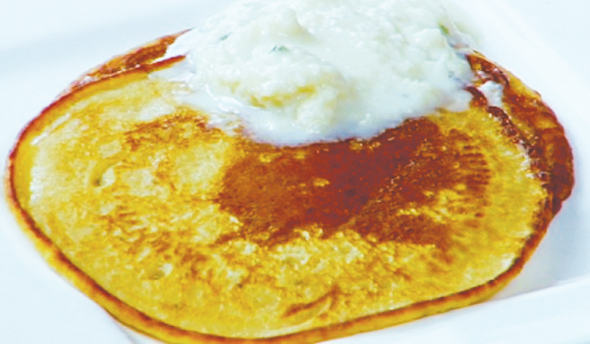Mama’s Punjabi Recipes: Metthe Pudde (Sweetened Flatbread)
The Punjab can be a bitter cold place during the winters and damp and cold during the rainy monsoon season, especially as most homes aren’t centrally heated. At these times, people long for foods and snacks that can warm them up in a hurry and give the extra boost of energy that lasts awhile, like hot masala chai, gur di gajak (jaggery peanut brittle), ravaddiyan (sesame sugar drops) or metthe pudde (sweetened flatbread).
And, as social etiquette is vitally important in Indian society, when an unexpected visitor should drop by a cold winter day, instead of running down to the corner halwai (confectioner) to buy some garma-garam (really hot) pakoras or samosas, it is much faster and easier to make some metthe pudde, which go down well with hot chai!
Metthe pudde are another comfort food made of whole wheat. They are soft and similar to pancakes except you don’t need to use any syrup as they are eaten just by themselves. Sometimes in weddings, to be native chic, you may get a desert of metthe pudde with sweet rabidri (congealed and condensed milk). If you prefer, you can make it with deep brown gur (jaggery, an uncentrifuged concentrated sugar made from cane juice), instead of sugar, for a different taste.
For the health conscious, the benefits of wheat instead of refined, bleached flour are that it is low in fat, high on fiber and is linked to reduce weight gain, the risks of stroke, type 2 diabetes, certain cancers and other health problems. Jaggery, on the other hand, acts as a digestive agent by providing lots of minerals and is a substitute for bleached, refined sugar.
Ingredients:
1 cup karank da atta (whole wheat flour)
1 cup chinni (sugar) – you can use ½ cup gur (jaggery) instead
½ cup ghee (clarified butter)
1 tsp saunf (fennel)
1 cup pani (water). You can also use 1 cup of milk instead of water.
Vegetable or sunflower oil to grease the hands and tava
Directions:
1. In a bowl, pour in the sugar and slowly add the water while mixing thoroughly with a spoon. (If you prefer to use jaggery, heat the water and add the gur. Stir till the gur is melted. Let it cool down for 30 minutes, then pour into the bowl instead of the sugar).
2. Pour the karank da atta in the bowl and add the saunf. Mix thoroughly till it is a soft paste.
3. Heat the tava or skillet on medium and then coat with a little bit of oil.
4. Pour a tablespoon full of the mixture on the tava. When it turns a little brown, flip it over. Wait for both sides to be browned but do not overcook else the pudda will burn.
5. Make the pudde out of the rest of the mixture. Serve while hot with hot tea or milk.
MAMA’S TIP OF THE WEEK
DON’T USE BAKING POWDER WHEN MAKING PAKORAS
Pakoras are probably the most common snack eaten almost all over India, but making good tasty pakoras requires not only the right spices but also the right batter mixture in order to get just the right texture too. Pakoras must have a light crunch, but sometimes the batter is too thin and almost falls off the vegetable or it is too hard and the pakoras come out tasting too dry.
In order to get the batter to be fluffy, some people add some baking soda when the mixture is being made. Although this will indeed provide a fluffy and soft feel, the batter will soak up more oil during frying and also will be too airy and have a slight after taste. It is better to experiment with the batter consistency than to use baking soda.
Shakuntla Malhotra is a skilled cook of Punjabi dishes made in the old-fashioned style that she learnt as a young woman in her ancestral home in Lyallpur, India before it became part of Pakistan after the Partition in 1947. People have often admired her cooking for its simplicity and taste that comes with each mouthful. Even in her mid-eighties, she continues to cook daily and agreed to share some of her delectable Punjabi recipes.


